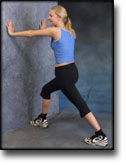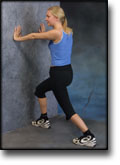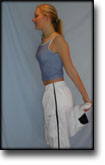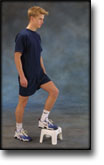|
The prevention of ankle sprains in sports. A systematic review of the literature. |
Kategoriarkiv: Rupture of the joint capsule
prevention-article1
|
The effect of preventive measures on the incidence of ankle sprains. DATA SOURCES. STUDY SELECTION. DATA EXTRACTION AND SYNTHESIS. MAIN RESULTS. CONCLUSIONS. |
examination-article1
|
Rupture of the tibiofibular syndesmosis without osseous fibular injury. |
STEP4
Training ladder for:
RUPTURE OF THE JOINT-CAPSULE AT THE FRONT OF THE ANKLE JOINT
(RUPTURA TRAUMATICA LIGAMENTI PEDIS)
STEP 4 |
Unlimited: Cycling. Swimming. Running with directional change.
|
|||||||||||||||||||||||||||||||||||||||||||||||||||||||||||||||
|
Stretching is carried out in the following way: stretch the muscle group for 3-5 seconds. Relax for 3-5 seconds. The muscle group should subsequently be stretched for 20 seconds. The muscle is allowed to be tender, but must not hurt. Relax for 20 seconds, after which the procedure can be repeated. The time consumed for stretching, coordination and strength training can be altered depending on the training opportunities available and individual requirements. |
STEP3
Training ladder for:
RUPTURE OF THE JOINT-CAPSULE AT THE FRONT OF THE ANKLE JOINT
(RUPTURA TRAUMATICA LIGAMENTI PEDIS)
STEP 3 |
Unlimited: Cycling. Swimming. Running straight ahead (without directional change).
|
||||||||||||||||||||||||||||||||||||||||||||||||||||||||||||
|
Stretching is carried out in the following way: stretch the muscle group for 3-5 seconds. Relax for 3-5 seconds. The muscle group should subsequently be stretched for 20 seconds. The muscle is allowed to be tender, but must not hurt. Relax for 20 seconds, after which the procedure can be repeated. The time consumed for stretching, coordination and strength training can be altered depending on the training opportunities available and individual requirements. |
STEP2
Training ladder for:
RUPTURE OF THE JOINT-CAPSULE AT THE FRONT OF THE ANKLE JOINT
(RUPTURA TRAUMATICA LIGAMENTI PEDIS)
STEP 2 |
Unlimited: Cycling. Swimming. Light running straight ahead (without directional change) on a smooth surface.
|
|||||||||||||||||||||||||||||||||||||||||||||||||||||||||
|
Stretching is carried out in the following way: stretch the muscle group for 3-5 seconds. Relax for 3-5 seconds. The muscle group should subsequently be stretched for 20 seconds. The muscle is allowed to be tender, but must not hurt. Relax for 20 seconds, after which the procedure can be repeated. The time consumed for stretching, coordination and strength training can be altered depending on the training opportunities available and individual requirements. |
STEP1
Training ladder for:
RUPTURE OF THE JOINT-CAPSULE AT THE FRONT OF THE ANKLE JOINT
(RUPTURA TRAUMATICA LIGAMENTI PEDIS)
STEP 1 |
| The indications of time after stretching, coordination training and strength training show the division of time for the respective type of training when training for a period of one hour. The time indications are therefore not a definition of the daily training needs, as the daily training is determined on an individual basis.
|
||||||||||||||||||||||||||||||||||||||||||||||||
|
Stretching is carried out in the following way: stretch the muscle group for 3-5 seconds. Relax for 3-5 seconds. The muscle group should subsequently be stretched for 20 seconds. The muscle is allowed to be tender, but must not hurt. Relax for 20 seconds, after which the procedure can be repeated. The time consumed for stretching, coordination and strength training can be altered depending on the training opportunities available and individual requirements. |






































